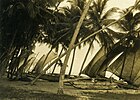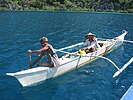Talk:Trimaran
| This article is rated C-class on Wikipedia's content assessment scale. It is of interest to the following WikiProjects: | ||||||||||||||||||
| ||||||||||||||||||
Addition[edit]
I added a bunch of information, created an ama page and a drogue page and a trampline_(multihull) page. But some of the information is a little redundant and I need to go to bed.
Safety argument[edit]
I removed the following counter safety argument:
- [This is highly questionable statement particularly given the ORMA 60 problems & recent snapping of Route du Rhum vessels in 2002. Capsizing is also inherently more likely at high speeds vs monohulls. Lifeboats and rescue vessels are invariably monohull because they are safer in foul weather.]
Because it was written as a talk page entry. --Van helsing 07:42, 24 July 2006 (UTC)
USS Independence (LCS-2)[edit]
The USS Independence (LCS-2) is being built with a trimaran design. I'm not sure how you want to go about editing this page in light of that, but it needs to be noted.
- This vessel actually does not belong to this article about saling vessels. Should be moved to engine driven trimarans. Lidingo SWE (talk) 05:52, 21 May 2009 (UTC)
Vandalism about Corsair?[edit]
Under the topic of folding designs, the blurb about Corsair is unrelated to the subject, and appears to be an advertisement. —Preceding unsigned comment added by 75.120.184.192 (talk) 05:29, 1 September 2010 (UTC)
Polynesian terminology - isn't plain English clearer?[edit]
The terms vaka, aka, and ama are said to be common terms. Perhaps this is so in America, but in the UK and Europe, this terminology is unheard of. Even assuming the Polynesian words to be as common in the USA as is claimed, I think it would be preferable to use the plain English equivalent terms (hull, outrigger, float, wings, beams, etc) as then all readers would understand the meaning immediately without further reference. Arrivisto (talk) 14:31, 13 June 2013 (UTC)
I agree that the term "ama" in particular is very common in the USA. The term "outrigger" implies to me the ama on an outrigger canoe, or even the entire canoe. The very popular classes of racing outrigger canoes are worldwide (OC-1, OC-2, OC-6). I would agree that the terms aka and vaka are less well known than ama. In the Philippines where almost all boats are trimarans they are referred to as "balancers". Amusingly (to someone raised in the monohull dominated Great Lakes) boats with out balancers are considered strange and un-seaworthy.
ZeroXero (talk) 19:08, 26 September 2016 (UTC)
Trimaran?[edit]

Hi Obsidian Soul I understand your reason for removing this image. I had to look hard to see that there is an outrigger on the opposite side, as well. My reason for including it over the image that you chose, is that I prefer to see only historical images in a "History" section, when possible. Perhaps we can find an image that is more obviously a historical one and where both outriggers are clearly visible. The photograph has further problems for me: it is dark and shows little boat per unit of area (these can be fixed with image adjustment and cropping); it also shows limp sails, which can't be fixed and makes for a static image, compared to the one that we are discussing in the Catamaran article. Cheers, HopsonRoad (talk) 0:02, 30 December 2019 (UTC)

- @HopsonRoad: Your image is a camakau. It does not have outriggers on the opposite side. Double-outrigger hull designs never reached Remote Oceania. I don't think we have a good quality "historical" image of traditional double-outriggers, hence my choice of a replica. Modern double-outriggers largely do not have sails. The colonial-era illustrations of double-outriggers are worse at showing details:
- Early 20th century photographs have a similar problem:
- Thank you for the clarification, Obsidian Soul and for your researching alternative images. I don't think that historical images have to show the other outrigger, as long as there is one. I have substituted a contemporary image of a paraw in the lead to better represent a world view. I have also cropped and lightened the Balatik image, although it doesn't appear to come across that way in articles, yet. Perhaps we can work some of the images that you have identified here into the Galleries. Cheers, HopsonRoad (talk) 17:54, 30 December 2019 (UTC)
- @HopsonRoad: Thank you. I think I'm good with the choices you've made for the images. Although you should probably retain the original Balatik image as another file in Commons, rather than overwriting. I'm not too keen on adding another gallery, but if you want to, a "Traditional trimarans" section might work. My choices would be any the following. Your call whether to use these or other images. Cheers.-- OBSIDIAN†SOUL 19:21, 30 December 2019 (UTC)
- Thank you for the clarification, Obsidian Soul and for your researching alternative images. I don't think that historical images have to show the other outrigger, as long as there is one. I have substituted a contemporary image of a paraw in the lead to better represent a world view. I have also cropped and lightened the Balatik image, although it doesn't appear to come across that way in articles, yet. Perhaps we can work some of the images that you have identified here into the Galleries. Cheers, HopsonRoad (talk) 17:54, 30 December 2019 (UTC)
- Obsidian Soul, I've restored the original Balatik image and created a cropped and lightened one that I have used here. I'll look at the images for a gallery, later. Cheers, HopsonRoad (talk) 20:00, 30 December 2019 (UTC)
Trimaran image removed[edit]

Hi HopsonRoad, I see that you have removed the image of the replica of Donald Crowhurst's trimaran Teignmouth Electron that I had added to Trimaran, with the explanation "Interesting story involving a trimaran. Unfortunately, the image doesn't contribute to understanding trimarans." Actually I beg to differ, it was a specially modified Piver design for ocean racing, which unfortunately failed to complete the most difficult leg because the entrant decided it was too risky (but that is another story), and of quite a lot of historic and popular interest (refer its own article Teignmouth Electron). Unfortunately there are no pix of the original boat in the public domain which is why I put up the replica as the next best option. I do not intend to argue the point indefinitely but I think adding this image to a gallery (presumably showing the potential range of sailing trimaran designs, presently numbering only four, but arguably, "notable trimarans" would not be out of scope either) is reasonable. Just my opinion of course, in case I can change your mind on this one. Cheers Tony Tony 1212 (talk) 03:34, 5 May 2020 (UTC)
- PS There is a better photo of the replica here: https://www.agefotostock.com/age/en/Stock-Images/Rights-Managed/WEN-wenn22551060 - unfortunately not available for WP use... Tony 1212 (talk) 08:04, 5 May 2020 (UTC)
- Hi Tony 1212, I moved this discussion here from my Talk page, since it pertains to this article and others can offer their opinions. Thank you for your posting and commentary. Before deleting the image, I looked at the Teignmouth Electron article. It describes adding some extra plies of material and extra bulkheads for ocean racing. I don't see much to distinguish it from many other catamarans, otherwise. Only two paragraphs in that extensive article have any references.
- Even if the Teignmouth Electron were notably different than other trimarans, the image is from a distance and shows barely more than the fact that the vessel is a trimaran—nothing is shown of its ocean-going gear or features. Thank you, again, for your interest and discussion. Cheers, HopsonRoad (talk) 13:10, 5 May 2020 (UTC)
Section on fast ferries[edit]
Hi Bogong, in reference to my deletion of material in the subject section, it had a number of problems:
- It was largely unsupported by Wikipedia:Reliable sources. A company press release is not an example of such.
- It contained what appeared to be original research, e.g. the first two sentences.
- It contained opinions, not consistent with Wikipedia:Neutral point of view, e.g. the last sentence.
I trimmed the section down to a statement that was supported by a reliable source. It would be better to build it from there with properly supported material, rather than restore problematic material wholesale. I'm happy to help you build this section in line with WP guidelines. Sincerely, HopsonRoad (talk) 00:31, 17 June 2020 (UTC)
A "replica" of a paraw?[edit]
There is a photo captioned "The Balatik, a paraw, a functioning replica of a traditional Austronesian sailing trimaran from the Visayas Islands of the Philippines", yet it shows a craft rigged with a completely conventional fore-and-aft sail and stay sails. Somehow I doubt that the Austronesians developed basically identical sail plans to those used in the Med and Europe, while at the same time adopting fundamentally different hull designs. The HULL is a replica, but the sails are not authentic. It even says in the text adjacent to the photo that most modern trimarans are fitted with modern sails like the bermuda rig, instead of crab claws or other unique forms of sail that would have been fitted on the original vessels. I understand that sails are not a rigid feature, and they can be changed, but if I showed a photo of "a replica of the USS Constitution" showing the famous frigate rigged out with a schooner rig on each mast, people would complain because it doesn't look or function like the original, and it's misleading to say it's a "replica" with such a fundemental difference. Idumea47b (talk) 04:22, 26 November 2020 (UTC)
- @Idumea47b: The use of a gaff rig is not native, but it can still count as partly accurate. During the colonial period of the Philippines, these traditional boats did adopt western rigs. Paraw and other large native sailing boats were pre-colonial, but they survived through the colonial period and up until around the 1970s. The 18th-19th century guilalo of Manila Bay for example, which was a very similar vessel, mixed native outriggers with western central rudders and settee sails. So the rigging here can still be considered accurate.
- The real problem though are the replicas of other balangay built by the National Museum of the Philippines. Those on the other hand are meant to depict more ancient pre-colonial Visayan balangay boats. Yet all of them don't have outriggers, and most of them use western rigs. -- OBSIDIAN†SOUL 12:01, 13 May 2021 (UTC)
- Thank you for addressing this question, Obsidian Soul. Since you say the description is "partly accurate", I feel it's best to reserve the word "replica" for something that's substantially accurate. Therefore, I propose that the caption should read: "The Balatik, a paraw derived from traditional Austronesian sailing trimarans of the Visayas Islands of the Philippines". What say you? Cheers, HopsonRoad (talk) 13:55, 13 May 2021 (UTC)
- @HopsonRoad: I meant partly accurate in the sense that it is accurate for colonial-era to early 20th-century balangay-type paraw. The goal of the Balatik is a revival of pre-1970s sailing paraws of the Visayas, not pre-colonial ships. The rig is perfectly fine. It's not pre-colonial, but it is a traditional paraw.-- OBSIDIAN†SOUL 00:08, 14 May 2021 (UTC)























